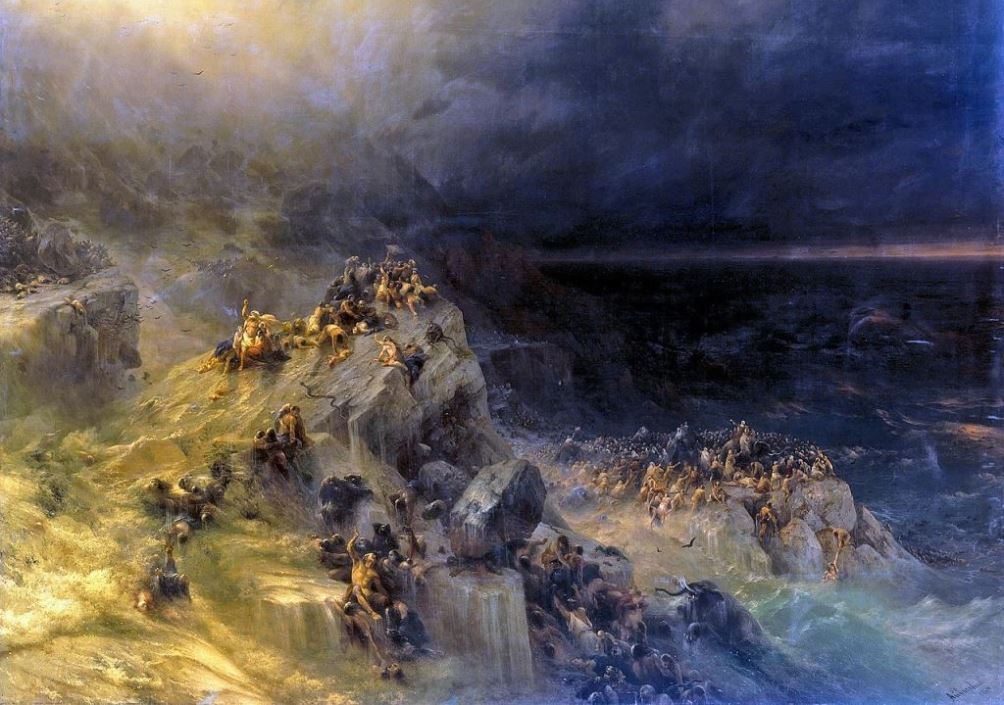Noah’s flood was a cataclysmic event with no parallels in recorded history. All of humanity (along with flora and fauna)—except for Noah and his family (and the animals he took with him into the Ark)—was wiped off the face of the earth. Some may call this catastrophic event the Great Extinction, others, the Great Destruction, but I would call it the Great Collapse. If we focus not only on what the Torah says but also on what it tells us, we notice that the Deluge is a metaphor for the collapse of the wave function—the key concept in quantum mechanics.
We often talked about the wave function collapse on this blog. However, for those who come here for the first time or feel they need a refresher, here is a very short summary of what the wave function is and what the collapse of the wave function means.
The wave function is a strange animal. Before we attempt to understand what it is, let us clarify what it is not. The wave function is not an observable quantity. It does not correspond to any physical property or quantity that could be measured. The wave function is a mathematical abstraction.[1] This mathematical object describes the distribution of probabilities of finding the system in a particular state. According to the Born rule—a key postulate of quantum mechanics—the wave function gives the probability that a measurement of a quantum system will yield a particular result.[2] It is important to remember that the wave function does not predict any specific result of measurement; it only predicts the statistical probability of finding a particular result in any given measurement. A single measurement in quantum mechanics is unpredictable. Only the statistical distribution of multiple measurements coincides with the probability distribution as predicted by the wave function.
In classical Newtonian physics, an object can only be in one state at a time. A top can spin only clockwise or counterclockwise but never both at the same time. In quantum mechanics, this rule no longer holds. The main equation of quantum mechanics, the Schrödinger equation, predicts that a quantum-mechanical object can be in a superposition of states. That means that a top can spin clockwise and counterclockwise simultaneously or that the spin of an electron can point up and down at the same time. It defies logic and intuition, but it is true. However, when we measure the state of an object, we always find the object in one specific state only. So long as we don’t “look” (that is, measure), a top can spin clockwise and counterclockwise, but when we “look,” we find the top spinning clockwise or counterclockwise, as it should, but never both. According to the Copenhagen interpretation of quantum mechanics, it is meaningless to speak about the state of a subatomic particle between measurements. Other interpretations taking the Schrödinger equation at its face value insist that the superposition of states is an essential albeit peculiar property of quantum mechanics.
Be that as it may, wave function collapse means that, on measurement, the plurality of states collapses into a single state. This is why this phenomenon is called the collapse of the wave function. It is also called the measurement problem because nobody knows why or how a measurement collapses the wave function.
What is important to us is that if, before the measurement, an object was in a superposition of multiple states, all states but one are destroyed during the collapse of the wave function. The information about those other states is irretrievably lost, which is why the collapse of the wave function is irreversible.
Now the parallel between Noah’s flood and the collapse of the wave function clearly emerges. In the antediluvian period (that is, before the flood), the earth was populated by many people. The deluge destroyed everyone except for one person—Noah (and his family). This is parallel to the destruction of all states except for one upon the collapse of the wave function. Thus, Noah’s flood can be seen as a metaphor for the collapse of the wave function.[3]
Endnotes:
[1] To be exact, it is a complex function defined on an infinite-dimensional Hilbert space.
[2] More exactly, the square amplitude of the wave function is equal to the probability of finding a particle in a particular area of phase space.
[3] One can object to this metaphor on the grounds that people are not quantum-mechanical states. True, but this is a metaphor, which is not to be taken literally. Moreover, it is not difficult to construct an abstract conceptual space where an individual inhabiting the planet Earth is viewed as a particular state of the planet. Our planet inhabited by all its denizens may be viewed to be in a superposition of states, where each state corresponds to the Earth inhabited only by one particular individual. A collapse of the wave function of such a system would be equivalent to destroying all inhabitants of the Earth (G‑d forbid!) but one.
